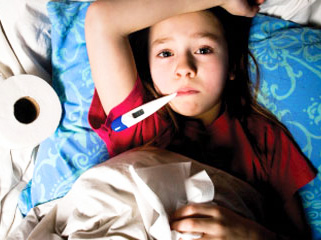
Christy Hammond of Bonney Lake, Wash., is hardly an anti-vax advocate. In fact, she makes sure her two children, 11 and 12, are up to date on all their vaccinations. With one notable exception: She routinely has them skip the annual flu shot, partly because she’s not sure about whether it really works. “When I worked at a place that gave them to employees, I got it, and always got sick after,” she says.
She’s not staunchly against the shot, she says. It’s just not a priority, and opting out is easy: Unlike other vaccinations, the flu shot is not required for enrollment in school or sports. (Washington state requires that children enrolled in school have an up-to-date immunization record, or a certificate or exemption on file.)
It’s true that the flu shot isn’t mandatory. But it is strongly encouraged: The Centers for Disease Control and Prevention (CDC) and the American Academy of Pediatrics recommend that all children 6 months and older get vaccinated against the flu each year. That’s because influenza can seriously sicken kids, who are more vulnerable to the virus.
“The absolute best way to protect your children against the flu is to get them vaccinated,” says Dr. Elizabeth Meade, assistant chief of pediatrics at Swedish Medical Center.
But each year, scores of parents skip it, even those like Hammond who routinely have their kids get other vaccines. Though the flu shot is recommended broadly with only a few exceptions (parents of children with certain neurological conditions or Guillain-Barré Syndrome should discuss vaccination with their child’s health-care provider), over 40 percent of children under 18 don’t get vaccinated each year.
But it’s just the flu
That may be due in part to flu’s mysterious rep. “We tend to use the word ‘flu’ for any contagious viral illness, so people don’t understand that influenza is a serious disease,” says Meade. Real influenza is no fun for adults: Up to two weeks of fever, chills, headache, body ache, chest discomfort, and sometimes vomiting. Because you’re contagious for up to 10 days after symptoms appear, the flu usually burns through a sizable chunk of your sick leave, if you’re lucky enough to have an employer who offers it. (Sorry, stay-at-home-caretakers — no paid time off for you.)
But as bad as the bug is for grown-ups, it’s worse for kids. Per the CDC, the littlest ones are most at risk: Severe complications from the flu — ranging from respiratory and ear infections to pneumonia and a potentially life-threatening inflammatory response called sepsis — are more common in children under 2.
Every year, the flu sends 20,000 children under age 5 to the hospital. And some don’t get better. During the 2014–2015 flu season, the CDC reported 148 influenza-related deaths in children; for the 2015–2016 season, the number was 85.
“Happy and healthy children get flu, and every year about half of the children who die from flu have no underlying medical conditions,” says Dr. Wendy Sue Swanson, executive director of digital health at Seattle Children’s Hospital and author of the Seattle Mama Doc blog. “This is a vaccine preventable illness!”
In order for the vaccine to prevent the flu, though, your kid has to get it. Here’s what you need to know about keeping your children healthy this year.
1. Mythbusting
Fear of catching the flu from the shot is the number-one concern voiced by parents, says Meade. This is a common and persistent myth, she says: The flu shot contains killed flu virus, so it’s impossible to get the illness from the shot. But because the flu shot takes two weeks to provide immune protection, it is possible to contract a virus, or even influenza, during the waiting period.
2. Better late than never
Our flu season runs later than the season in the rest of the country. “Our flu activity tends to peak between January and March, and we see influenza still circulating late into the spring,” says Meade. What this means: If you put off getting your kids vaccinated until December, or later, it’s still worthwhile to get the shot, because there are months of flu season left.
3. Take a shot
Shot-avoidant kiddos may have some tears in store: As of this year, the nasal-mist vaccine is no longer recommended, due to concerns about its effectiveness. As it turns out, 97 percent of nasal mist recipients weren’t protected from the flu; by contrast, the shot reduces the risk of flu illness by 50 to 60 percent.
4. Double dose
Some children need double doses of flu vaccine for full protection. Children older than 6 months who’ve never received a flu shot, or have only received one in their lifetime, require two shots at least 28 days apart. Children who have previously received two doses of the flu vaccine at any point only need one shot.
5. Protection times three (or four)
Each year, the flu vaccine protects against several influenza strains deemed by scientists to be most likely to circulate. “Trivalent” vaccines protect against three viruses: Two influenza A viruses (H1N1 and H3N2) and an influenza B virus; “quadrivalent” vaccines provide protection against the same three viruses, plus an additional B virus. Both are effective, says Meade, so she advises parents to get whichever version is offered by their child’s health care provider.
The fact that the flu shot doesn’t protect against each and every flu virus isn’t reason to skip it, says Meade. Even if your child contracts one of the viruses that’s not included in that year’s vaccine, they’ll tend to have a milder illness if they’ve been vaccinated against the flu, she notes.
Also not an excuse: Fear of nasty side effects. For most children, side effects are exceedingly mild, says Swanson. The most common flu shot side effects, tenderness at the shot site and a low-grade, short-term fever in up to a third of children under 2 years old, are easily treatable with an ice pack, OTC meds like Tylenol or Ibuprofen, and some TLC. Post-shot, plan for a mellow evening at home—and look forward to fewer sick days in your child’s future.












